 |
 |
|
||
 |
||||
Printer Specifications
Mechanical
|
Printing method:
|
24-pin impact dot matrix
|
|
|
Printing speed:
|
High speed draft
|
300 cps at 10 cpi
360 cps at 12 cpi |
|
Draft
|
225 cps at 10 cpi
(337 cps at 15 cpi maximum) |
|
|
Letter quality
|
79 cps at 10 cpi
|
|
|
Printing direction:
|
Bidirectional logic seeking for text and graphics printing. Unidirectional text or graphics printing can be selected using software commands.
|
|
|
Line spacing:
|
1/6-inch or programmable in 1/360-inch increments
|
|
|
Printable columns:
|
80 columns (at 10 cpi)
|
|
|
Resolution:
|
Maximum 360 × 180 dpi (letter-quality mode)
|
|
|
Paper feed methods:
|
Friction (front)
Push tractor (rear) |
|
|
Reliability:
|
Total print volume
|
20 million lines
(except print head) MTBF 10,000 POH (25% duty) |
|
Print head life
|
Approx. 400 million strokes/wire
|
|
|
Dimensions and weight (with paper guide):
|
Height
Width Depth Weight |
185 mm (7.3 inches)
386 mm (15.2 inches) 306 mm (12.0 inches) Approx. 3.5 kg (7.7 lb) |
|
Ribbon:
|
Black ribbon cartridge
|
S015290
|
|
Ribbon life
|
Approx. 3.5 million characters
(at 10 cpi in the letter-quality mode with 48 dots/character) |
|
|
Acoustic noise:
|
Approx. 57 dB (A) (ISO 7779 pattern)
|
|
 Note:
Note:|
The paper-thickness lever position or an overheated print head may affect the print speed.
|
Electronic
|
Interfaces:
|
One standard bidirectional, 8-bit, parallel interface with IEEE 1284 nibble mode support, one USB 2.0 (Full Speed) interface slot
|
|
Buffer:
|
32KB
|
|
Built-in fonts:
|
Bitmap fonts:
EPSON Draft 10, 12, 15 cpi
EPSON Roman 10, 12, 15 cpi, proportional EPSON Sans Serif 10, 12, 15 cpi, proportional EPSON Courier 10, 12, 15 cpi EPSON Prestige 10, 12 cpi EPSON Script v EPSON Script C proportional EPSON Orator 10 cpi EPSON Orator S 10 cpi EPSON OCR-B 10 cpi |
|
Scalable fonts:
EPSON Roman 10.5, 8 to 32 points, in 2-point increments
EPSON Sans Serif 10.5, 8 to 32 points, in 2-point increments EPSON Roman T 10.5, 8 to 32 points, in 2-point increments EPSON Sans Serif H 10.5, 8 to 32 points, in 2-point increments SV Busaba 10.5 pt., 8 to 32 points, in 2-point increments SV Jittra 10.5 pt., 8 to 32 points, in 2-point increments |
|
|
Barcode fonts:
EAN-13, EAN-8, Interleaved 2 of 5, UPC-A, UPC-E, Code 39, Code 128, POSTNET
|
|
|
Character tables:
|
One Italic and 14 graphical character tables:
Italic table, PC437 (US, Standard Europe), PC850 (Multilingual), PC860 (Portuguese), PC863 (Canadian-French), PC865 (Nordic), PC 858, ISO 8859-15, KU42 (Thai), TIS11 (Thai), TIS18 (Thai), TIS17 (Thai), TIS13 (Thai), TIS16 (Thai), TSM/WIN (Thai)
|
|
Character sets:
|
14 international character sets and one legal character set:
USA, France, Germany, UK, Denmark I, Sweden, Italy, Spain I, Japan, Norway, Denmark II, Spain II, Latin America, Korea, Legal
|
Electrical
|
220 to 240 V Model
|
|
|
Input voltage range
|
198 - 264 V
|
|
Rated frequency range
|
50 - 60 Hz
|
|
Input frequency range
|
49.5 - 60.5 Hz
|
|
Rated current
|
0.8 A (maximum 1.5 A depending on the character type)
|
|
Power consumption
|
Approx. 28 W (ISO/IEC 10561 letter pattern)
Approx. 9 W in ready mode
Approx. 0.4 W in sleep mode*
0 W in power off
|
* sleep mode: When the configured time passes in the following conditions, the printer enters sleep mode.
- No operation
- No error
- There is no data in input buffer
- No operation
- No error
- There is no data in input buffer
 Note:
Note:|
Check the label on the back of the printer for the voltage of your printer.
|
Environmental
|
Temperature
|
Humidity
(without condensation) |
|
|
Operation (plain paper)
|
5 to 35 ˚C (41 to 95 ˚F)
|
10 to 80% RH
|
|
Operation (recycled paper or label)
|
15 to 25 ˚C (59 to 77 ˚F)
|
30 to 60% RH
|
|
Storage
|
-30 to 60 ˚C (-22 to 140 ˚F)
|
0 to 85%
|
Paper
 Note:
Note:|
Use recycled paper and labels only under normal temperature and humidity conditions, as follows:
Temperature: 15 to 25 ˚C (59 to 77 ˚F) Humidity: 30 to 60% RH Do not load paper that has been folded or is damaged, wrinkled, or curled.
|
Single sheets
See also Multipart forms for detailed information on the specification for single-sheet multipart forms.
|
Width
|
90 to 257 mm (3.5 to 10.1 inches)
|
|
Length
|
70 to 364 mm (2.8 to 14.3 inches)
|
|
Thickness
|
single sheets:
0.065 to 0.14 mm (0.0025 to 0.0055 inch) multipart forms:
0.12 to 0.39 mm (0.0047 to 0.015 inch) |
|
Weight
|
single sheets:
52 to 90 g/m² (14 to 24 lb) multipart forms:
40 to 58 g/m² (11 to 15 lb) |
|
Quality
|
single sheets:
Plain paper and recycled paper multipart forms:
Carbonless or carbon-backed multipart forms with a line of glue at the top or the side of the form Multipart forms that are joined together along the left and right edges by crimping or spot-gluing* |
|
Copies
|
1 original + 4 copies
|
* When using 4 inches or wider but less than 9.4 inches wide multipart forms joined by crimping (multipart forms with cut-paper tab binding), set the Multipart forms with cut-paper tab binding in the default-setting mode to on.
Continuous paper
See also Multipart forms for detailed information on the specifications for continuous multipart forms.
The sprocket hole must be a circle or notched circle.
The holes must be cleanly cut.
At the perforation between pages, the horizontal and vertical perforation cuts must not cross.
The ratio of the cut/uncut length at the perforation should be between 3:1 and 5:1. The perforation between pages must not extend all the way to the edges of the paper.
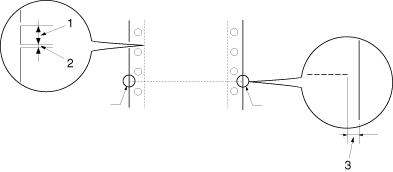 |
|
1. cut area
2. uncut area
3. uncut part of the edges of the paper
|
If you use continuous paper whose page length (A in the next illustration) is under 101.6 mm (4.0 inches), make sure that the length between folds (B) is over 101.6 mm (4.0 inches.)
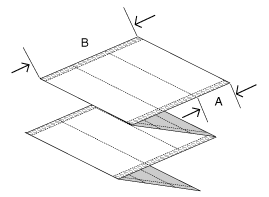
|
Width
|
101.6 to 254.0 mm (4.0 to 10.0 inches)
|
|
Length/page
|
101.6 to 558.8 mm (4.0 to 22.0 inches)
|
|
Copies
|
1 original + 4 copies
|
|
Total thickness
|
0.065 to 0.39 mm (0.0025 to 0.015 inch)
|
|
Weight
|
single sheets:
52 to 82 g/m² (14 to 22 lb) multipart forms:
40 to 58 g/m² (11 to 15 lb) (weight/part) |
|
Quality
|
single sheets:
Plain paper, recycled paper, carbonless, and carbon-backed multipart forms:
Multipart forms that are joined together along the left and right edges by crimping or spot-gluing* |
* When using 4 inches or wider but less than 9.4 inches wide multipart forms joined by crimping (multipart forms with cut-paper tab binding), set the Multipart forms with cut-paper tab binding in the default-setting mode to on.
Multipart forms
The specifications for the dimensions of multipart forms are the same as those for single sheets and continuous paper. See Single sheets and Continuous paper for detailed information.
The form sheets of continuous multipart forms should be securely joined together along the left and right edges by crimping or, spot-gluing. For the best printing quality, use multipart forms joined with spot-gluing.
|
spot-gluing
|
|
 |
|
|
crimping
|
|
 |
|
|
spot-gluing and crimping on each side
|
|
 |
|
|
1. 1 inch or less
2. 3 inches or less
3. printing side
4. 1 inch or less
5. 3 inches or less
| |
 Note:
Note:|
When using 4 inches or wider but less than 9.4 inches wide multipart forms joined by crimping (multipart forms with cut-paper tab binding), set the Multipart forms with cut-paper tab binding in the default-setting mode to on.
|
 Caution:
Caution:|
Never use continuous multipart forms that are joined with metal staples or bar-gluing.
|
 |
 |
|
1. bar-gluing
2. metal stapling
|
|
The thickness of the folded part when extended should be 1 mm or less.
 |
|
* 1 mm or less
|
The binding area should be flat and have no creases.
The sprocket holes should be a circle or a notched circle.
The sprocket holes of all sheets in the form should be aligned properly.
The binding position should be outside the recommended printable area. See Recommended printable area for more information.
Labels (single-sheet)
Labels should be securely attached to the backing sheet and the label surface must be flat.
The labels should not peel off their backing sheet under the conditions below.
 |
wrapping drum radius
wrapping angle
wrapping time
ambient temperature
ambient humidity
|
27 mm
180 ˚
24 hours
40 ˚C
30%
|
|
1. label
2. 27 mm
|
||
Always use labels whose backing sheet is entirely covered, and make sure the cuts around the edges of the labels are perforated.
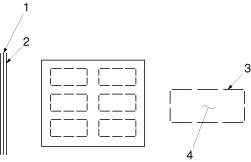 |
|
1. backing sheet
2. label sheet
3. several uncut areas on each side
4. label
|
|
Backing sheet
|
Width
|
100 to 210 mm (3.9 to 8.3 inches)
|
|
Length
|
100 to 297 mm (3.9 to 11.7 inches)
|
|
|
Labels
|
Width
|
63.5 mm (2.5 inches), minimum
|
|
Height
|
23.8 mm (0.94 inch), minimum
|
|
|
Weight
|
64 g/m² (17 lb)
|
|
|
Thickness
|
Backing sheet
|
0.07 to 0.09 mm (0.0028 to 0.0035 inch)
|
|
Total
|
0.16 to 0.19 mm (0.0063 to 0.0075 inch)
|
|
|
Quality
|
Plain paper or the same quality labels with backing sheet
|
|
Labels (continuous forms)
Labels should be securely attached to the backing sheet and the label surface must be flat.
The labels should not peel off their backing sheet under the conditions below.
 |
wrapping drum radius
wrapping angle
wrapping time
ambient temperature
ambient humidity
|
27 mm
180 ˚
24 hours
40 ˚C
30%
|
|
1. label
2. 27 mm
|
||
When using labels whose backing sheet is entirely covered, make sure the cuts around the edges of the labels are perforated.
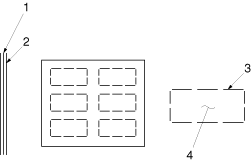 |
|
1. backing sheet
2. label sheet
3. several uncut areas on each side
4. label
|
When using labels whose backing sheet is not covered with the label material, see the illustration below.
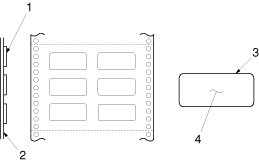 |
|
1. label
2. backing sheet
3. corner radius is more than 2.5 mm
4. label
|
|
Backing sheet
|
Width
|
101.6 to 254 mm (4 to 10 inches)
|
|
Length/page
|
101.6 to 558.8 mm (4 to 22 inches)
|
|
|
Labels
|
Width
|
63.5 mm (2.5 inches), minimum
|
|
Height
|
23.8 mm (0.94 inch), minimum
|
|
|
Corner radius
|
2.5 mm (0.1 inch), minimum
|
|
|
Weight
|
64 g/m² (17 lb)
|
|
|
Thickness
|
Backing sheet
|
0.07 to 0.09 mm (0.0028 to 0.0035 inch)
|
|
Total
|
0.16 to 0.19 mm (0.0063 to 0.0075 inch)
|
|
|
Quality
|
Plain paper or the same quality labels with continuous backing sheet
|
|
Recommended printable area
 Note:
Note:|
For best results, print within the recommended printable area. The printer may not print outside this area.
|
Single sheets (including single-sheet multipart forms):
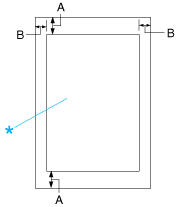
|
A
|
4.2 mm (0.17 inch) or more
|
|
B
|
The minimum left and right margins are 3.0 mm (0.12 inch) each.
|
|
*
|
recommended printable area
|
|
The maximum printable width is 203.2 mm (8.0 inches). For single sheets wider than 209.2 mm (8.24 inches), the side margins increase proportionally to match the width of the paper.
|
|
Continuous paper (including continuous multipart forms):
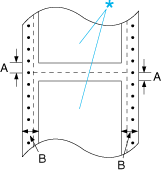
|
A
|
The minimum top and bottom margins (above and below the perforation) are 4.2 mm (0.165 inch).
|
|
B
|
The minimum left or right margin is 13 mm (0.512 inch).
The maximum printable width is 203.2 mm (8.0 inches). For paper wider than 229.2 mm (9.0 inches), the side margins increase proportionally to match the width of the paper. |
|
*
|
recommended printable area
|
Labels (single-sheet):
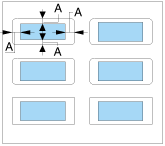
|
A
|
3 mm (0.118 inch) or more
|
Label (continuous form):
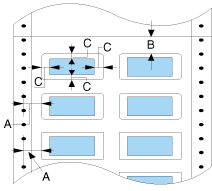
|
A
|
6.35 mm (0.25 inch) or more
|
|
B
|
1.2 mm (0.0472 inch) or more
|
|
C
|
3 mm (0.118 inch) or more
|
